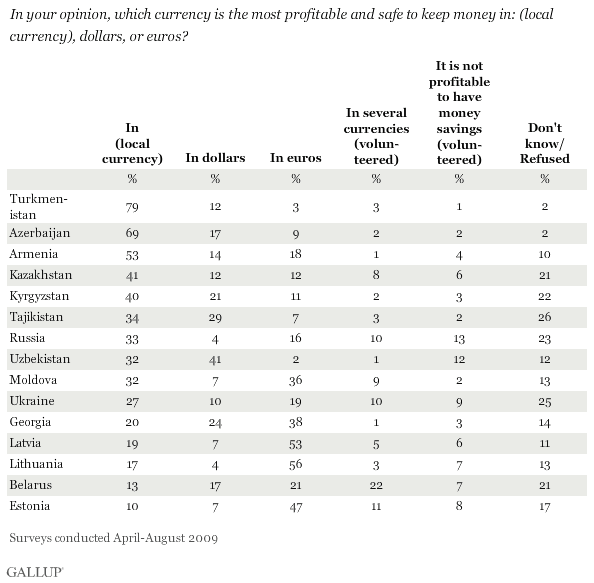WASHINGTON, D.C. -- The dollar is not king in most former Soviet nations. In its place, Gallup surveys this year show residents in 12 of 15 countries are more likely to view their own local currency or the euro as the most profitable and safest to keep their money in.

For decades the U.S. dollar has been the world's reserve currency, often desired by many (including those in many former Soviet countries) over their own. But the dollar's weakness in recent years has made it less attractive and may help explain why, with the exception of Uzbekistanis, Belarusians, and Tajikistanis, residents in so many former Soviet countries see their own currencies or the euro as the safest. People in some of these countries, such as Kazakhstan and Armenia, still exhibit more faith in their own currencies than any other asked about -- even though they've seen their local legal tender lose value this year.
Faith in Local Legal Tender Varies
Although residents in most former Soviet countries surveyed tend to see their own currencies as the most profitable and safe to keep their money in, support levels vary tremendously within the region. Turkmens are the most likely of those surveyed to say their currency is safest and most profitable (79%), with the dollar placing a distant second (12%) and the euro a remote third (3%).

Belarusians and Estonians, on the other end of the spectrum, are the least likely to say their own currencies are the safest and most profitable. Nearly half of Estonians (47%) choose the euro, while 1 in 10 or fewer choose their own currency (10%) or the dollar (7%). In Belarus, which devalued its currency this year and pegged its money to the ruble, dollar, and euro, results are understandably more mixed -- a relatively high percentage (22%) says keeping money in several currencies is most profitable and safe.
Euro Cash Favored in EU Member States, Georgia, and Moldova
Residents in Lithuania, Latvia, and Estonia -- European Union (EU) member states that maintain their own currencies -- show a strong preference for the euro over their own local legal tender and the dollar. They are the most likely of all surveyed to pick the euro, with about half of residents in each country choosing this currency as the most profitable and safe.

Although not European Union members, Georgia and Moldova have grown closer with the European Union in recent years. Possibly reflecting these warming relations, Georgians are also more likely to identify the euro (38%) as the safest and most profitable currency to keep their money in over their own (20%) and the dollar (24%). In Moldova, residents notably are as likely to choose the euro (36%) as their own currency (32%).
Top Dollar in Uzbekistan
Uzbekistan, which also has seen its share of currency problems this year, is the only country surveyed in which residents are more likely to say the dollar is the best to keep one's money in. Forty-one percent of Uzbekistanis choose the dollar, while 32% pick their own currency as the most profitable and safe.

Overall, trust in the dollar is highest in Uzbekistan, and roughly one-quarter or more in Georgia (24%) and Tajikistan (29%) choose the dollar as the most profitable and safe currency. Further, in most former Soviet countries in Central Asia, residents are still more likely to pick the dollar over the euro.
Bottom Line
Although the U.S. dollar has strengthened recently, Gallup data suggest that international dependency on the U.S. dollar -- in terms of its perceived strength on a global stage -- is in doubt. Residents in many former Soviet countries are more likely to see their local currency or the euro as the most profitable and safe, which may make them more receptive to the idea -- floated by Russia, China, and others earlier this year -- of replacing the dollar as the world's reserve currency with a supernational currency.
For complete data sets or custom research from the more than 150 countries Gallup continually surveys, please contact worldpollpartners@gallup.com or call 202.715.3030.
Survey Methods
Results are based on face-to-face interviews with between 500 and 2,000 adults, aged 15 and older, conducted April-August 2009 in Armenia, Azerbaijan, Belarus, Estonia, Georgia, Kyrgyzstan, Kazakhstan, Latvia, Lithuania, Moldova, Russia, Tajikistan, Turkmenistan, Ukraine, and Uzbekistan. For results based on the total sample of national adults, one can say with 95% confidence that the maximum margin of sampling error ranges from ±2.8 percentage points in Russia to ±5.3 percentage points in Lithuania. The margin of error reflects the influence of data weighting. In addition to sampling error, question wording and practical difficulties in conducting surveys can introduce error or bias into the findings of public opinion polls.
